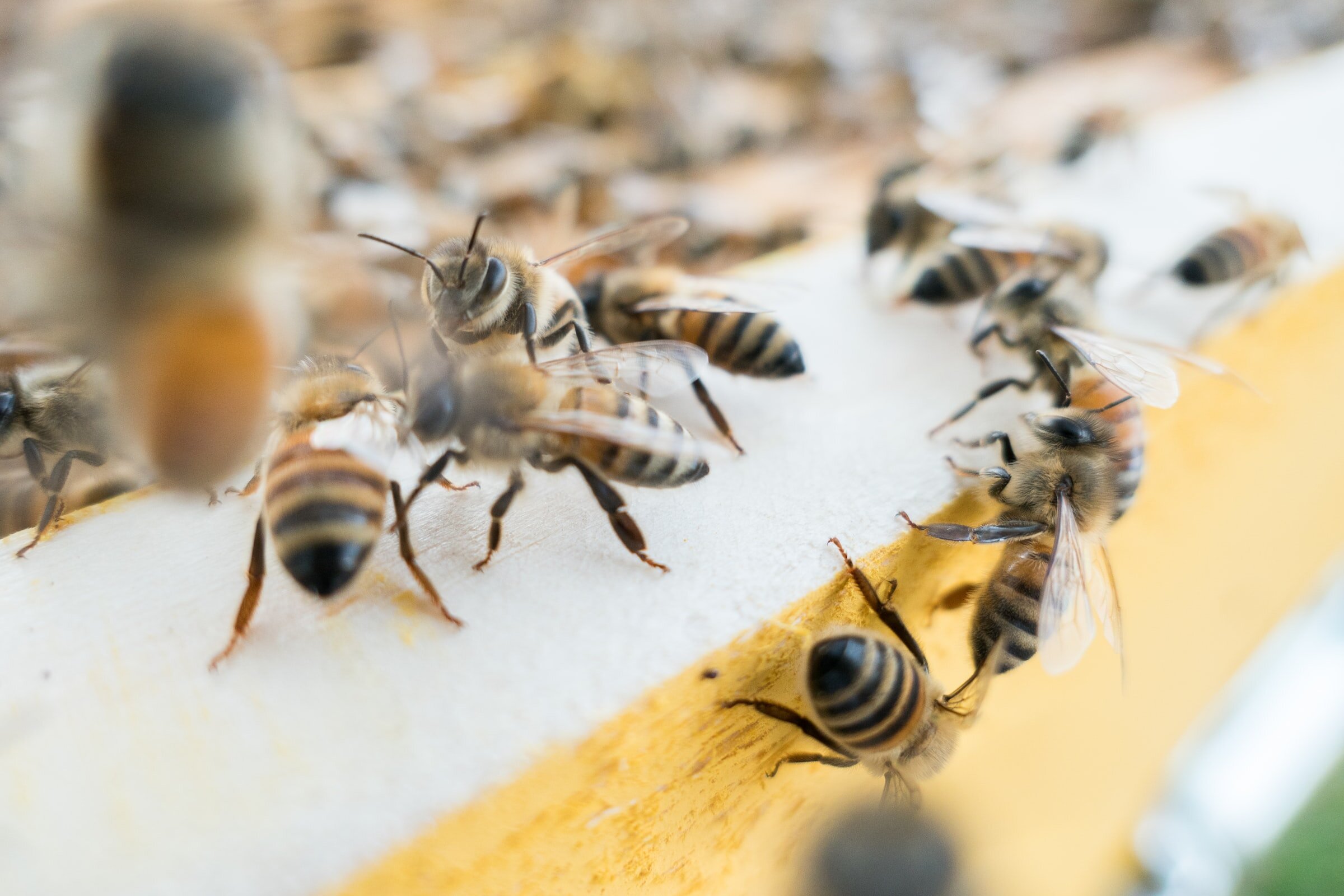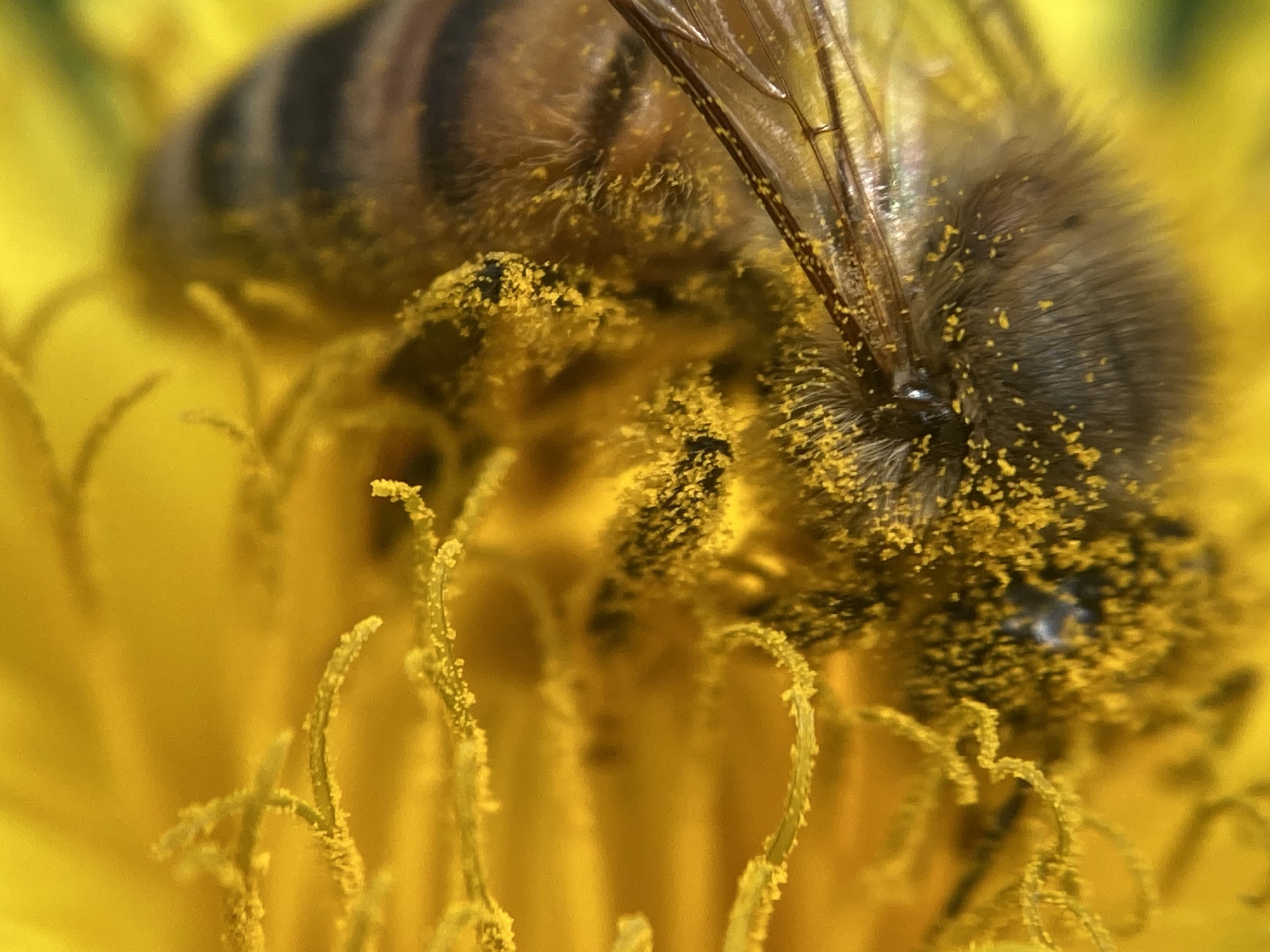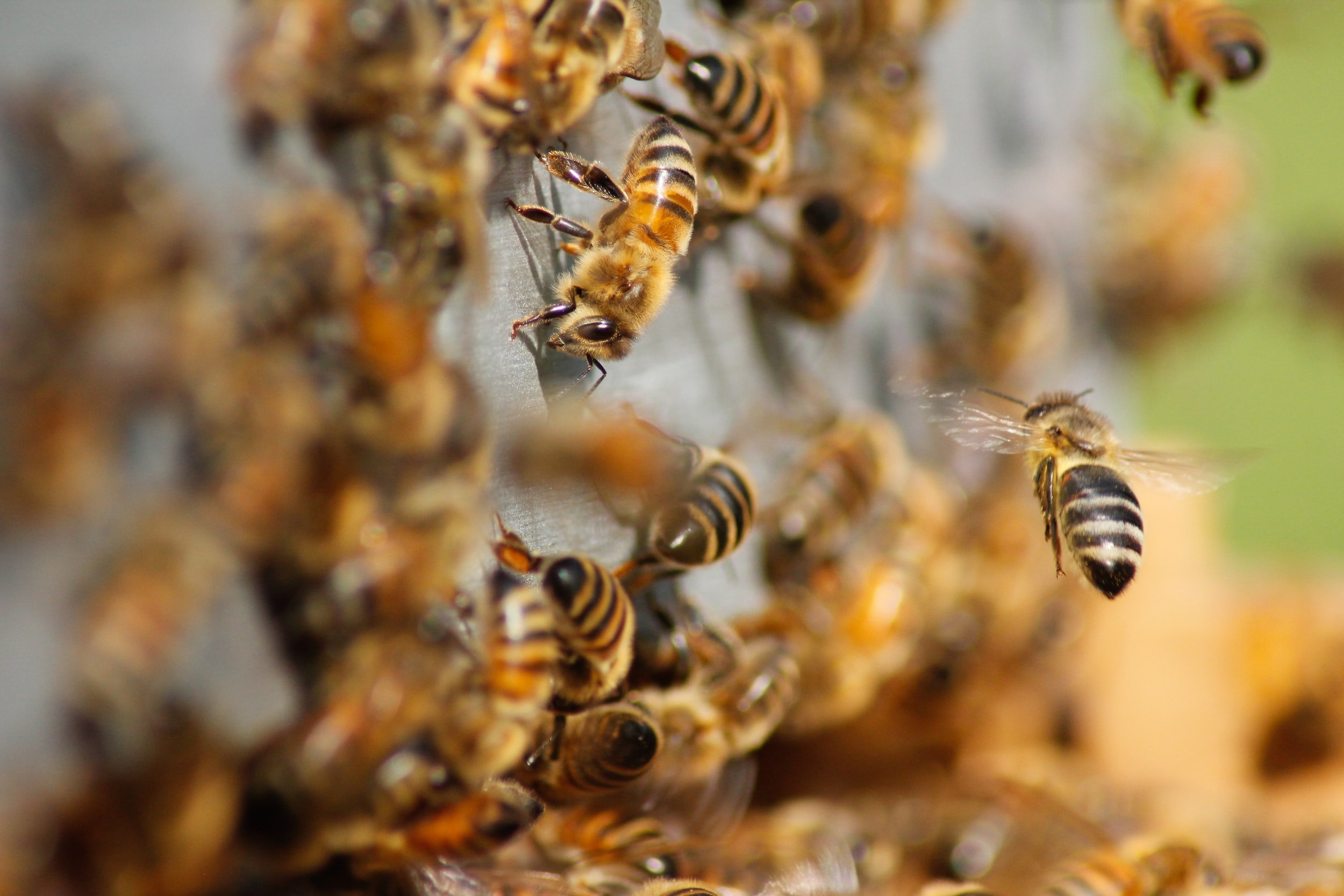
Honey Bees!
Welcome to the world of Honey Bees!
The lovely flowers embarrass me,
They make me regret I am not a bee.
- Emily Dickinson
What is a Honey Bee?
Simply, a Honey Bee is a small vegetarian insect which lives in a highly structured colony with thousands of its sisters (and a few brothers along with one Queen), all working toward the goal of storing enough food (honey) for the winter when flowers are not present.
So let’s unpack the above over the course of this page, because honey bees have had a long history with and without humans, as our friends, foes and future. The more we understand them, the better we are able to adapt to their needs and not the other way around.
So wait…what is a Honey Bee?
Well a Honey Bee is a small striped stinging insect (yes they have a barbed stinger and venom) which gathers pollen and nectar from flowers and turns it into honey. A Honey Bee is not every bee you see in the world as there are over 20,000 different species of bees. Honey Bees are one of the only bees which produce honey, therefore they are called Honey Bees or Honeybees. Either spelling is correct and don’t let anyone else tell you otherwise, ok - let’s move on.
Honey Bees generally all look the same, although there are several different subspecies such as Carniolan, Russian, etc. They have a striped abdomen, alternating between yellow and black. Their abdomen is covered in dense hair (often branching or forked) and their head has 5 eyes, along with two medium length antenna. They have a straw like tongue which allows them to slurp up nectar from flowers and bring it back to their hive. With six legs they are able to manipulate the pollen which they gather from flowers to feed to their brood.
Where do Honey Bees live?
Honey Bees are native to Africa, Asia and some parts of Europe, and now span the entire globe, except Antarctica. Regional variations in Honey Bees (such as subspecies) are evident in their handling of predators and others environmental pressures, such as Varroa mites.
Honey Bees nest above ground in tree hallows, between walls in buildings, and everywhere in-between. They are highly adaptable and able to live anywhere which affords them a dry space. Feral, or Wild colonies of Honey Bees primarily live in high up in tree snags or hallows, which allow for maximum southern exposure and protection from the elements. They prefer a south facing entrance as it captures the first rays of sunlight each day, warming the entrance and enticing them to start their day.
With the domestication, if you can really call it that, of honey bees, humans have designed every shape and size of box to put bees in. Some beekeepers are on a never ending quest to find the ‘perfect’ hive for Honey Bees, while most beekeepers in North America prefer Langstroth style hives. Regardless of hive design, beekeepers seek to provide the same 3 principles; an insulated, dry and predator free space which allows bees to thrive and expand.
As a side note a 2020 study Global Patterns and Drivers of Bee Distribution has shown that as a whole, bee species show the greatest diversification in arid regions with minimal forests and tall trees, which often block sunlight from stimulating the growth of diverse flowering brush. As this research grows we are able to better predict and protect these key areas with the goal of maintaining the diversity of the bee species, because everyone loves variety!
Honey Bee Pollination
Honey Bees are great pollinators but are far from the most effective or efficient within the bee species. Yet, what they lack in effectiveness they make of for in numbers with large colony sizes. Like all bees, Honey Bees need a diverse mix of floral sources to provide a rich diet of pollen and nectar. The act of pollination, which moves pollen from one flower to another of the same species is not an intentional one.
Honey Bees are drawn to flowers to gather either nectar or pollen and in the process will inadvertently transfer pollen from one flower source to another. Once the pollen is transferred from one flower to another of the same species the receiving flower will become pollinated and start to set fruit.
As you can see in the photos pollen color differs by flower and a highly dense protein source which is feed to their growing young. Only female bees forage to provide resources for the hive such as nectar and pollen. When done collecting pollen (often times they may be covered in it) they will groom their entire bodies and pack the pollen onto their rear legs which have specially designed hairs which are long and stiff.
These so called “pollen baskets” hold the sticky pollen in place while they are flying as a way to transport the material back to their hive. Once at the hives she will pull the pollen off her legs and pack it into a wax cell for later user. Soon after another bee will come to mix saliva, and honey into the mixture making what is often referred to as “Bee Bread”. This bee bread is what is fed to young larva to bolster their growth.

Close up of pollen on a honey bee while she is foraging…
How are Honey Bees used in commercial agriculture?
Honey Bees have been used for the pollination of crops since humans took up an agrarian lifestyle back in ancient Egypt. Our use of Honey Bees speaks to our deep love and mutualism which helps both our species thrive. With the advent of highly industrialized mono-culture farms honey bees have become even more important as hundreds of acres are planted with a single crop which needs to be pollinated all at the same time. In situations like these, with a prime example occurring in California’s Central Valley, Honey Bee hives are placed on large flatbed trailers and dropped off at different farms.
Once there the honey bees will stay for several weeks while they pollinate the crop. Once the crop has been pollinated the beekeeper will come back to the farm and load the bees back onto the semi-truck and move them onto the next farm. The beekeeper needs to move the honey bees once the crop has been pollinated as there will no longer be flowers for the bee to feed on. Not only does the beekeeper receive money for providing this pollination service but the bees continue to grow and make honey in the process while the farmer receives the benefit of a pollinated crop which will now bear fruit such as apples, almonds, pears, etc.
Honey Bee Hives
Honey Bee Hives, or Colonies look for nesting space any place possible above ground. That crack in the side of your house, the spare tire lying on the ground, a cozy tree hallow, these are all places a honey bee colony may choose as a nest site. They are primarily looking for a small entrance with a large interior space which seems to provide protection from the elements. Once these conditions have been met it is off to the races on their growth within that space and once they fill it they will swarm to a new home.
Once a colony finds a new home they immediately start building their hive using wax. Young female workers, festoon, which is where they hang from each other and secret wax from the bottom of their abdomen and work it into shape with their mouth. They are able to precisely control the shape and size of each cell by measuring with their antenna. The use the minimal amount of wax to build the walls of each cell and measure the thickness by biting the cell wall. Not only do bees strive to make as thin of cell walls as they can to save on precious wax resources, but during the winter “heater bees” enter into cells and generate heat to help the hive survive while clustered. Having thin walls means that more of that heat is able to be dispersed into the cluster.
Once there are enough cells they will start to store pollen and nectar in them as well as the queen will begin laying the first eggs in the new colony.
Honey Bee Colony Structure
The hierarchical structure of a honey bee colony is similar to that of the common Bumblebee, in that, there are three types of bees: Queen, Workers & Drones.
Queens
Honey Bee Queens, have the ability to live for multiple years and may lay between 1,500 - 2,000 eggs a day during the spring and summer. Inside the hive they are completely dependent on “attendant or nurse bees” to groom, feed and guide them. They are fed a mixture of honey, pollen and royal jelly throughout their life to ensure they are strong and healthy.
The Queen Bee will only leave the hive a few times in her life; first after she is born on one or two nuptial mating flights and if the colony swarms. On her mating flight she will mate with upwards of 15 Drones (male honey bees), storing the sperm from each in a special organ. Once she is laying eggs in the hive, she is able to determine if she would like to fertilize the egg with the stored sperm, making it a Worker (female), or lay an unfertilized egg, which will grow into a Drone (male).
Within the hive the Queen Bee is essentially held captive by her daughters. Since they take care of her in every fashion they control how much food she eats and where she may move in the hive. For instance, if a colony is preparing to swarm, the attendant bees will put her on a diet and workout plan by continually pulling at her legs to keep her moving around the hive and feed her less. They are looking to cause her to loose weight to prepare her for leaving the hive.
The Queen Bees is the only bee in the hive which may lay fertilized eggs as she uses pheromones to suppress the ovarian development of all the Worker bees. However, there are instances where a Worker bee may start laying within the hive, but she is only able to lay un-fertilized Drone (male) eggs. Typically, if a beekeeper sees a laying Worker bee it is an indication that the Queen is starting to get old and is failing.
As a Queen ages and starts to fail her daughters will take notice and begin preparations to replace her. They will set about nurturing several eggs into new queens, which is achieved by feeding the larva Royal Jelly and enlarging the cell to make it into a large peanut shape. The Workers will actively steer her away from the areas where they are raising her replacement to ensure she does not kill he developing larva. Once the new Queens hatch they will immediately take to their mating flight and upon returning do battle with the existing Queen in an attempt to kill her. If successfully she will go around the hive and kill the other unborn Queens in their cells to cement her place in the hive.
Workers
The workers in the nest are all the daughters of the Queen, as noted above, she has the ability to determine how many and when to increase or decrease the number of workers in the nest dependent on season and incoming pollen and nectar resources. Workers in the hive start off performing basic housecleaning duties, including cleaning their own cell, nursing new larva, building comb, fanning nectar into honey, and guarding the entrance. Once they have completed their tenure in the hive they are sent out into the world as forager bees tasked with collecting nectar and pollen for the hive. This is by far the most dangerous job of their lives as they face predation from many insects and birds - she will continue this job until she dies.
Drones
If there is one bee that has a great life in the nest, it is the Drone. Drones are actually haploid, meaning they come from an unfertilized egg, therefore they have no father. Don't worry though, their life is on easy street, once born they relax in the nest eating honey and staying warm. They are able to drift between hives consuming honey as needed without fear of being attacked. During the daytime Drones congregate in what are called “Done Congregation Areas” or DCAs where they wait for a virgin Queen to pass by. Upon spotting a Queen they race to mate with her and upon the termination of copulation the Drone’s abdomen rips open and he dies. If the Drone fails to mate during the season he will be kicked out of the hive by the Worker bees at the start of Fall and die. This ensures the colony is able to make it through the winter on their limited honey supply.
Additional Honey Bee Resources
Our hopes for the above information is to provide you with a jumping off place to further your understanding of the Honey Bee. If you are looking to dive deeper into this fascinating insect you might want to explore these additional resources:
Honeybee Democracy - Thomas Seeley
Honey Bees - Wikipedia
Queen Bees - Penn State University










